
Illumine Yokohama 2025
Kim BergströmThe Illumine Yokohama event runs throughout December at Yamashita Park, and there are several different displays to appreciate.

Yamashita Park (山下公園) is a public park along YokoThe Yamashita Park is considered the first coastal park in Japan and is located directly in front of the port of Yokohama. It extends almost 700 meters from the east side of Osanbashi to the Yamashita Pier. It was founded in 1930 by filling the area with the debris of the great Kanto earthquake opened.
The park includes a meadow of grass, a rose garden, the "Little Girl in Red Shoes" statue, the "Guardian of the Water" statue, which is a gift from San Diego, a sister city of Yokohama, and the memorial to that Song "" Kamome no Suihei-san (Seagull Sailor) "", a water staircase and a stage.
The former cargo and passenger ship Hikawamaru is anchored here.hama's waterfront. The park was built using landfill from the remains of buildings destroyed in the Great Kanto Earthquake of 1923.
Yamashita Park is a 3-minute walk from the Motomachi-Chukagai Station (Minatomirai Line); a 1-minute walk from the Yamashita Koen-mae bus stop on City Bus #26, departing from the Sakuragi-cho Station (JR or Yokohama City Subway)

The Illumine Yokohama event runs throughout December at Yamashita Park, and there are several different displays to appreciate.

Get ready to experience some seasonal magic at Winter Wonder Park Yokohama, running from early December until early March at the picturesque Yamashita Park. At the heart of the experience is an eco-friendly skating rink set against a backdrop of winter lights and sounds.
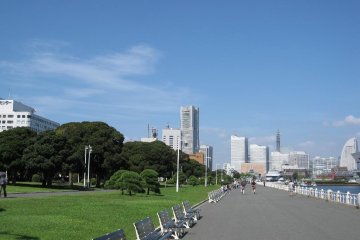
As one of the best-known landmarks of Yokohama city, Yamashita Park attracts a lot of tourists as well as local citizens day and night.
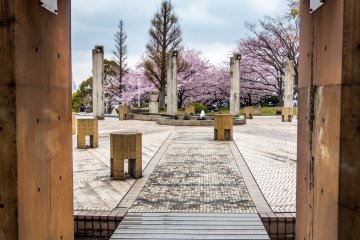
Come and experience one of Yokohama`s most popular attractions during the spring; everything covered in a rich and colorful blanket of pink and white petals.
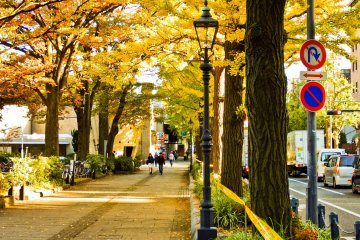
Come and experience the full spectacle of autumn`s beautiful colors at Yokohama`s number one park. Yamashita Park.
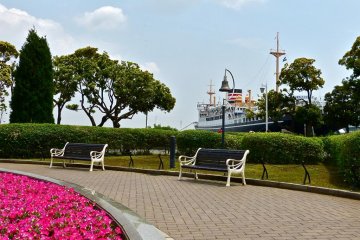
Yamashita Park is the most popular park among them. Locals always come here to refresh themselves, and tourists can’t resist it either.
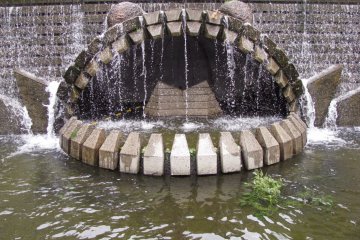
Yamashita Park located in Yokohama is a special design of water cascades and is good for a family to walk around in

Yamashita Park: One of the most iconic places in the port city, Yokohama! This is my favorite park!

The Future Rose Garden, in Yamashita Park, Yokohama opens each spring in May & June and autumn in October & November. Reopened in 2016, there are over 160 species of roses and attracts many people, adding to the park's popularity.

Great fun! The Yokohama Parade, Yamashita Park, and vicinity during Golden Week!

The world's first full-scale MOVING Gundam! Standing at over 18m tall, this full-scale moving replica of Mobile Suit Gundam Model RX-78F00 is the latest addition to the modern skyline of Yokohama city.

Yokohama's dragon boat races take place off of Yamashita Park every year in late May and early June.

The Illumine Yokohama event runs throughout December at Yamashita Park, and there are several different displays to appreciate.

Get ready to experience some seasonal magic at Winter Wonder Park Yokohama, running from early December until early March at the picturesque Yamashita Park. At the heart of the experience is an eco-friendly skating rink set against a backdrop of winter lights and sounds.

The elegant building facing Yamashita Park, is one of the oldest hotels in Yokohama: the Hotel New Grand.

Navios Yokohama is a reasonably priced hotel in an excellent location in the Aka-Renga Shoping District. The view from the guest room is pretty nice!

To properly see Yokohama, you need a good quality hotel with a central location. Hotel MyStays Yokohama Kannai is my first choice.

Perfect for couples or groups (up to 12 people), Masago provides enticing kaiseki dining that is delicious and artistic. Try their classic Japanese-style cuisine that has been altered for a more international taste while retaining the harmony of its original flavors.

RUCY+R boasts a delicious and colorful vegan menu. You won't be disappointed by the Hawaiian-inspired cafe where you can try Mexican taco salad, tofu-katsu, and curry with an extra kick of veggies.

Enjoy high-quality authentic Chinese food such as dim sum, congee, and noodles at MS. CASABLANCA. This casual Chinese dining space is chic and comfortable, providing high-class Chinese dining in Kanagawa supervised by a Michelin Star chef.

Kanteibyo Temple (関帝廟) is a spiritual landmark in Yokohama’s Chinatown. It shines like a beacon of faith with its vibrant red exterior and intricate detailing. Dragon statues stand above the entrance with poised bodies and open mouths, fiercely guarding the temple. The interior is decorated ornately with gold designs, wordlessly speaking of the temple’s significance. In the center sits a statue of Guan Yu, a famous military general turned deity who is immortalized in the historical Chinese novel, Romance of the Three Kingdoms. Worshippers pray to Guan Yu for business and financial prosperity. History Founded in 1862, Kanteibyo was allegedly created when a Chinese migrant brought a statue of Guan Yu to Japan. The temple started humbly as a small shrine but expanded over the years thanks to donations from devout worshippers. Kanteibyo’s history was a turbulent one, as it stood witness to numerous calamities. In 1923, the temple was destroyed by an earthquake; years later it was damaged in 1945 during World War II air raids; and in 1986, it burned down due to an unsolved fire incident. After each destructive event, the town united to rebuild the temple, reflecting the residents’ deep sense of community and connection with each other and the temple. Today Kanteibyo has become entrenched in Chinatown’s legacy and is a frequented site by residents and tourists alike for prayer and admiration. The temple is dedicated to seven deities, all of which--except the Jade Emperor who is symbolized by the ceiling--are represented by lavishly adorned statues. These deities include the Jade Emperor, Guan Yu, Di Mu Niang Niang, Zhou Cang, Guan Ping, Guan Yin, and Fu De Zheng Shen. Centered in the temple is Guan Yu’s statue, which is red-faced, long bearded, and cloaked in brightly-colored attire. The most common way of praying involves the use of incense sticks. While fire is prohibited in the main shrine, worshippers can light the incense sticks outside and place them in five burners corresponding to the shrine’s deities. After lighting the incense, practicers enter the main building and pray to the deities in a specific order. Temple assistants can also help people tell their fortunes with the use of divination moon blocks. The temple holds celebratory events throughout the year with the most popular ones being on New Year, Lunar New Year, and Guan Yu’s birthday. These spectacles are filled with traditional Chinese performances such as lion and dragon dances.

Masobyo Temple (媽祖廟), also called Ma Zhu Miao, is located in Yokohama’s Chinatown. The young Taoist temple, which opened relatively recently in 2006, enshrines Mazu, the Chinese Goddess of the Sea. Despite its young age, the temple exudes ancient spirituality older than its years. The structure has a geometrical base and is decorated with blue, green, red, and gold detailing. A massive gate welcomes visitors and worshippers alike and is connected to the main temple with a line of red lanterns. Inside Masobyo, a statue of Mazu is cloaked in vibrant attire and wearing an imperial headdress, symbolizing her godly status. The interior is equally as impressive as the outside with exquisite designs covering every surface. Worshippers commonly go to the temple to pray for safe travels since, historically, sailors and fishermen would pray to the goddess for calm seas during their journeys. History of Mazu: Goddess of the Sea As a human, Mazu was born in the tenth century and named Lin Mo. According to legend, she was gifted with supernatural abilities, such as predicting the weather, calming storms, and experiencing visions. She dedicated her life to the teachings of Tao and ascended to the heavens at age 28 as a goddess. Mazu has two demon bodyguards, Qianliyan and Shunfenger. Both demons vowed to protect Mazu after failing to defeat her in combat for her hand in marriage. Inside Masobyo, statues of the demon guardians stand to the left and right of Mazu. One, colored red, is positioned in a listening pose with his hand to his ear, while the green colored one is diligently watching, with eyes that seem to scan the temple. Today Worshippers visit Masobyo to pray to Mazu for safe travels, as well as general health and safety. The temple is also a popular spot for tourists due to its traditional architecture and cultural significance in Chinatown. Of course, Mazu’s affinity for keeping travellers safe is appealing to tourists as well. Masobyo’s temple staff are extremely helpful and more than willing to teach visitors the appropriate methods of worship. Individuals who want a closer look at Mazu’s statue are required to buy incense sticks, which they place in five burners. After lighting the incense sticks, they should bow in respect. During New Years, the temple becomes crowded with people participating and watching the festive displays.
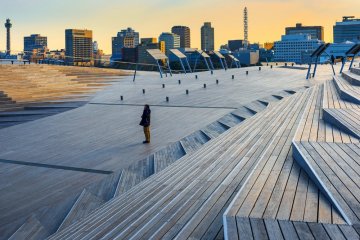
Yokohama International Passenger Terminal, also known as Osanbashi or Yokohama Port, is located at Osanbashi Pier. Osanbashi Pier, located between Minato Mirai and Yamashita Park / Chinatown, is the most important international port terminal for Japan due to its proximity to Tokyo many cruise lines from around the world stop by. The 400 meter long pier has walkways and green spaces that are open to the public. It was originally built in 1894, but converted into a passenger terminal in 2002. The pier is one of the best places in Yokohama to get an unobstructed view of the Minato Mirai skyline. There are also shops, restaurants and a hall for small exhibitions and events here.